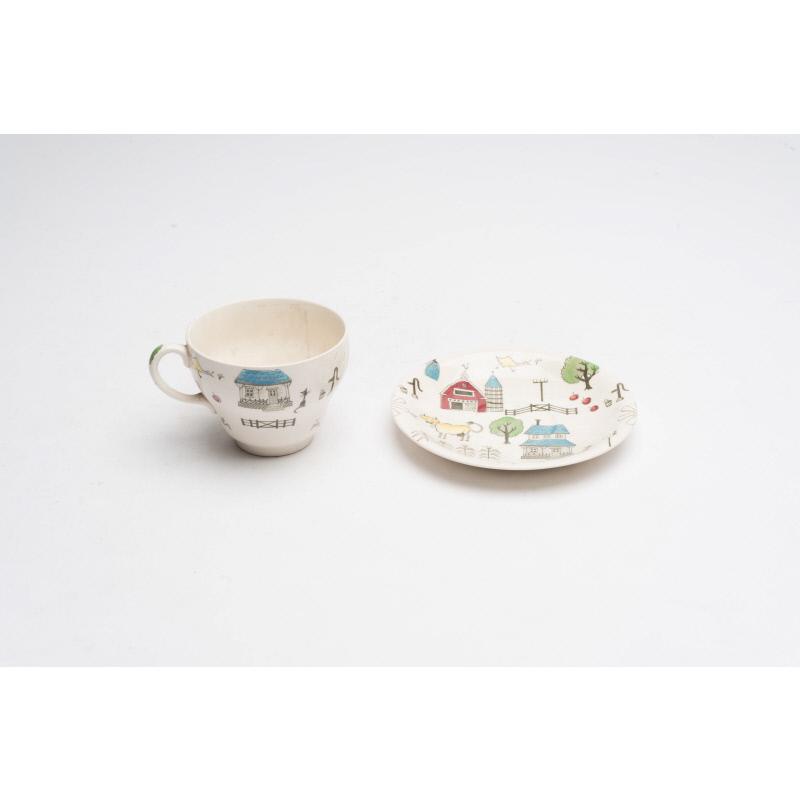Currently indexing
Cup and saucer
Classification(s):
Pottery
Date: 1955
Dimensions:
76 × 145 mm (7.6 × 14.5 cm)
Medium: Ceramic
Object number: CC043
(not assigned):England
Title:McDonalds Farm
DescriptionGlazed ceramic ‘McDonalds Farm’ cup and saucer, designed and manufactured by Johnson Bros. (Hanley) Ltd., dated 1955. Made in England. The design is hand engraved and hand filled under the glaze and depicts an American style farmstead with buildings, crops, a windmill, a letterbox, water pump and animals including cows, cats and ducks.
Maker’s mark stamped to base “McDonalds Farm Made in England by Johnson Bros a genuine hand engraving all decorations under the glaze detergent and acid resisting colour pat pend”. Paper label to base “10.9.56 Johnson Bros. (Hanley) Ltd. Hanley 1 London Saucer. Pareek Moderne “McDonald’s Farm”, 389 Green Print. w/glaze & Handfilled”.
Maker’s mark stamped to base “McDonalds Farm Made in England by Johnson Bros a genuine hand engraving all decorations under the glaze detergent and acid resisting colour pat pend”. Paper label to base “10.9.56 Johnson Bros. (Hanley) Ltd. Hanley 1 London Saucer. Pareek Moderne “McDonald’s Farm”, 389 Green Print. w/glaze & Handfilled”.
ProvenanceThis object was originally acquired for the Inner London Education Authority’s (ILEA) ‘Circulating Design Scheme’ collection.
The collection was instigated by the London Country Council (later the Greater London Council) and the Council of Industrial Design (COID). The collection’s original purpose was concerned with the teaching and dissemination of modern, ‘good design’.
The collection was established in 1951/52 as the ‘Experiment in Design Appreciation’, later renamed the ‘Circulating Design Scheme’.
The Circulating Design Scheme lent boxed showcases to London schools. The showcases contained handling objects, material samples and interpretation on a specific subject.
COID withdrew its involvement in the Scheme in 1957. After which time, it was managed exclusively by the London County Council from 1957-1963.
After the administrative restructuring of London authorities, the Scheme was jointly managed by the Greater London Council and the Inner London Education Authority (ILEA) from 1963 – 1976.
The Scheme was operational until 1976 when the collections were withdrawn from circulation. ILEA was abolished in the late 1980s and the collection was donated to Camberwell College of Arts in 1989/90.
ILEA was responsible for secondary and tertiary education in the inner London boroughs, this included Camberwell.
The collection was instigated by the London Country Council (later the Greater London Council) and the Council of Industrial Design (COID). The collection’s original purpose was concerned with the teaching and dissemination of modern, ‘good design’.
The collection was established in 1951/52 as the ‘Experiment in Design Appreciation’, later renamed the ‘Circulating Design Scheme’.
The Circulating Design Scheme lent boxed showcases to London schools. The showcases contained handling objects, material samples and interpretation on a specific subject.
COID withdrew its involvement in the Scheme in 1957. After which time, it was managed exclusively by the London County Council from 1957-1963.
After the administrative restructuring of London authorities, the Scheme was jointly managed by the Greater London Council and the Inner London Education Authority (ILEA) from 1963 – 1976.
The Scheme was operational until 1976 when the collections were withdrawn from circulation. ILEA was abolished in the late 1980s and the collection was donated to Camberwell College of Arts in 1989/90.
ILEA was responsible for secondary and tertiary education in the inner London boroughs, this included Camberwell.
NotesThis object was circulated to London schools as part of the Inner London Education Authority’s (I.L.E.A) Circulating Design Scheme, which operated from 1951-1976. The cup and saucer featured in the ‘Commercial Pottery’ group, c. 1954. Therefore this object dates to the early years of the Scheme’s operation. Photograph of display © Design Council / University of Brighton Design Archives.






